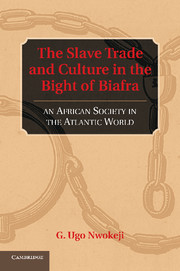Book contents
- Frontmatter
- Contents
- List of Tables and Figures
- Map of the Bight of Biafra and Its Hinterland
- Preface
- Foreword by Paul E. Lovejoy
- 1 Introduction
- 2 The Aro in the Atlantic Context: Expansion and Shifts, 1600s–1807
- 3 The Trade Diaspora in Regional Context: Aro Commercial Organization in the Era of Expansion, 1740–1850
- 4 Culture Formation in the Trading Frontier, c. 1740 to c. 1850
- 5 Household and Market Persons: Deportees and Society, c. 1740–c. 1850
- 6 The Slave Trade, Gender, and Culture
- 7 Cultural and Economic Aftershocks
- 8 Summary and Conclusions
- Notes on Sources
- Sources Cited
- Index
Foreword by Paul E. Lovejoy
Published online by Cambridge University Press: 06 December 2010
- Frontmatter
- Contents
- List of Tables and Figures
- Map of the Bight of Biafra and Its Hinterland
- Preface
- Foreword by Paul E. Lovejoy
- 1 Introduction
- 2 The Aro in the Atlantic Context: Expansion and Shifts, 1600s–1807
- 3 The Trade Diaspora in Regional Context: Aro Commercial Organization in the Era of Expansion, 1740–1850
- 4 Culture Formation in the Trading Frontier, c. 1740 to c. 1850
- 5 Household and Market Persons: Deportees and Society, c. 1740–c. 1850
- 6 The Slave Trade, Gender, and Culture
- 7 Cultural and Economic Aftershocks
- 8 Summary and Conclusions
- Notes on Sources
- Sources Cited
- Index
Summary
The interior of the Bight of Biafra has been somewhat of an enigma in the attempt to reconstruct the history of Africa during the era of transatlantic slavery. Its importance in the peopling of the Americas is clear. Perhaps one in six enslaved Africans came from the region. And while there is disagreement in estimating the relative proportions of people who can be identified as Igbo, Ibibio, and other ethnic categories and, indeed, in the meaning of these categories, it does seem certain that most people came from the relatively densely populated areas immediately inland from the coast behind the Niger Delta. Although Portuguese and other European traders did acquire some enslaved Africans from the Bight of Biafra in the sixteenth and seventeenth centuries, the overwhelming majority of people from the region left in the eighteenth and nineteenth centuries, and especially in the century after circa 1730. The enigma is that it has been difficult to document this migration, the causes of enslavement, and any relevant political and economic factors that might explain the phenomenon and its timing.
The reason for this difficulty relates to two factors. First, there is a paucity of documentary and oral sources that might be used in historical reconstruction for the eighteenth and early nineteenth centuries. Second, there seems to be what might be called a “wall of silence” in the region about the past. Perhaps the lack of centralized institutions that can preserve details of the past explains this problem.
- Type
- Chapter
- Information
- The Slave Trade and Culture in the Bight of BiafraAn African Society in the Atlantic World, pp. xxiii - xxivPublisher: Cambridge University PressPrint publication year: 2010



